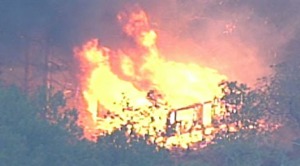article by Pat Raia from the page of The Horse
Timely Tips to Protect the Lives of your Horses, Burros and Mules
“As most of you know my wife Terry, co-founder of Wild Horse Freedom Federation, is sheltering evacuated horses and donkeys at our farm in Magnolia, Texas where the fire is burning only a few miles away. Likewise, she stands at the ready to help our Director of Wild Burro Affairs, Marjorie Farabee, who is on evacuation standby with her dozens and dozens of donkeys, mules and burros…so this story and information strikes very close to our heart. We hope that you will find it of interest, also.” ~ R.T.
photo courtesy of KHOU News, Houston
Throughout the Labor Day weekend, Texas horse owners used Facebook and other Internet avenues to share news about available resources including transportation, feed, and shelter beyond the fire zone. But veteran firefighter Gina Gonzales, of the Loveland Fire Rescue in Loveland, Colo., and an assistant instructor for The Large Animal Emergency Rescue Inc. (TLAER), said evacuation is not an option for some owners. When that’s the case, owners should take these “shelter in place” steps before the fire advances:
- Stock water: Fill every available bucket, trough, and other container with enough water to accommodate animals for between five and seven days.
- Stock feed: Horses sheltered in place should have enough feed to accommodate them for between five and seven days.
- Gather hand tools: Have metal shovels and heavy-duty metal rakes on hand to extinguish cinders that might fall onto your property. “Wind can carry cinders as far as a quarter mile,” Gonzales said. “Hand tools are the best way to extinguish them.”
- Gather equine identification information: Owners will need definitive identification to reclaim animals displaced during a wildfire event or other disaster from animal control or welfare authorities.
- Mark your animals: Animals should also be marked with the owner’s name and contact information. Gonzales recommends owners use indelible markers to write this information on horses’ hooves, or on duct tape placed on the horses’ neck or buttocks.
- Mark your property: Place placards on property fence gates informing firefighters that animals are being sheltered in place there. Owners should also include their names and contact information.
- Remove horses from barns: Horses should be relocated from barns even if those structures are equipped with sprinkler systems. Paddocks or metal-construction areas provide safer shelter. Close up the barn to prevent scared horses from running back inside and becoming trapped.
- Be alert to signs of smoke inhalation: Along with risk of lacerations and other injuries, horses sheltered in place run the risk of smoke inhalation. Owners should be able to recognize signs that their horses have inhaled smoke. “If you see soot around your horse’s eyes or coming out of its nose, that horse has been breathing smoke,” Gonzales said.
“If owners find their horses coughing, sneezing, or breathing more heavily than usual, they should seek treatment as soon as possible,” Taraba said.
For an inspiring and gripping first-hand account of how the Louisiana State University‘s Equine Rescue Team saved hundreds of horses and other animals following the devastation of Hurricane Katrina, read Horses of the Storm. ~ you will read of the efforts of Habitat for Horses and the role that Terry Fitch played in the rescue operations.”Finally, Gonzales recommends that owners residing in wildfire-prone areas reduce fire-damage risks by creating so-called “defensible spaces” around their properties.
Defensible spaces are 100-foot perimeters that surround barns, paddocks, homes, and other structures. These spaces are devoid of overgrown brush, flammable chemicals, or trees that could fuel cinders emanating from wildfires.
“If you have a defensible space, be sure your horses are placed within it if you have to shelter in place,” Gonzales said.
Related articles
- Smoke From Texas Wildfires Raises Concerns – PHOTOS: Wildfires Rage Across Texas (foxnews.com)
- Raging Texas Wildfires Destroy Nearly 1,400 Homes (foxnews.com)
- Texas wildfire’s toll makes big jump (news.blogs.cnn.com)
- Texas Wildfires Claim 852 Homes in 48 Hours (abcnews.go.com)
- Worst Tex. fire 100% contained, but risks remain (cbsnews.com)
- Equine Advocacy Blog Hits 1 Million Viewer Milestone (rtfitch.wordpress.com)









No comments:
Post a Comment